Military history of Nova Scotia
| Part of a series on the |
| Military history of Nova Scotia |
|---|
 |
During the
Seventeenth century
Port Royal established
The first European settlement in Nova Scotia was established in 1605. The
Approximately seventy-five years after Port Royal was founded, Acadians migrated from the capital and established what would become the other major Acadian settlements before the Expulsion of the Acadians: Grand Pré, Chignecto, Cobequid and Pisiguit.
The English made six attempts to conquer the capital of Acadia which they finally did in the Siege of Port Royal in 1710. Over the following fifty years, the French and their allies made six unsuccessful military attempts to regain the capital.[3]
Scottish and French Conflict
From 1629 to 1632, Nova Scotia briefly became a Scottish colony. Sir William Alexander of Menstrie Castle, Scotland claimed mainland Nova Scotia and settled at Port Royal, while Ochiltree claimed Ile Royale (present-day Cape Breton Island) and settled at Baleine, Nova Scotia. There were three battles between the Scottish and the French: the Siege of Baleine (1629), the Siege of Cap de Sable (present-day Port La Tour, Nova Scotia) (1630) and the Raid on Saint John (1632), . Nova Scotia was returned to France via the Treaty of Saint-Germain-en-Laye (1632).[4]
The French quickly defeated the Scottish at Baleine and established settlements on Ile Royale at present day Englishtown (1629) and St. Peter's (1630). These two settlements remained the only settlements on the island until they were abandoned by Nicolas Denys in 1659. Ile Royale then remained vacant for more than fifty years until the communities were re-established when Louisbourg was established in 1713.
Acadian Civil War
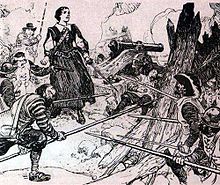
Acadia was plunged into what some historians have described as a civil war between 1640 and 1645. The war was between Port Royal, where Governor of Acadia Charles de Menou d'Aulnay de Charnisay was stationed, and present-day Saint John, New Brunswick, where Governor of Acadia. Charles de Saint-Étienne de la Tour was stationed.[5]
In the war, there were four major battles. la Tour attacked d'Aulnay at Port Royal in 1640.[6] In response to the attack, D'Aulnay sailed out of Port Royal to establish a five-month blockade of La Tour's fort at Saint John, which La Tour eventually defeated (1643). La Tour attacked d'Aulnay again at Port Royal in 1643. d'Aulnay and Port Royal ultimately won the war against La Tour with the 1645 siege of Saint John.[7] After d'Aulnay died (1650), La Tour re-established himself in Acadia.
In 1674, the
King Philips War
During
Wabanaki Confederacy
In response to
King William's War
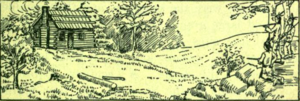
During
At the end of the war England returned the territory to France in the
Eighteenth century
Queen Anne's War
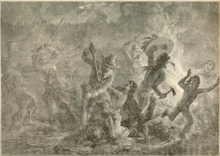
During

During
40th Regiment of Foot
The
Father Rale's War
During the escalation that preceded
As a result of the escalating conflict, Massachusetts Governor
The worst moment of the war for the capital came in early July 1724 when a group of sixty Mikmaq and Maliseets raided Annapolis Royal. They killed and scalped a sergeant and a private, wounded four more soldiers, and terrorized the village. They also burned houses and took prisoners.[17] The British responded by executing one of the Mi'kmaq hostages on the same spot the sergeant was killed. They also burned three Acadian houses in retaliation.[18]
As a result of the raid, three blockhouses were built to protect the town. The Acadian church was moved closer to the fort so that it could be more easily monitored.[19]
In 1725, sixty Abenakis and Mi'kmaq launched another attack on Canso, destroying two houses and killing six people.[20]
The treaty that ended the war marked a significant shift in European relations with the Mi'kmaq and Maliseet. For the first time a European Empire formally acknowledged that its dominion over Nova Scotia would have to be negotiated with the region's indigenous inhabitants. The treaty was invoked as recently as 1999 in the
King George's War

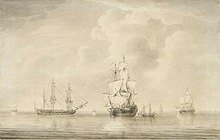
News of war declarations reached the French
Father Le Loutre's War

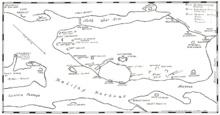
Despite the British takeover of the capital at the
Within 18 months of establishing Halifax, the British also took firm control of peninsula Nova Scotia by building fortifications in all the major Acadian communities: present-day Windsor (
Seven Years' War
The final colonial war was the Seven Years' War. The British Siege of Port Royal happened in 1710. Over the next forty-five years the Acadians refused to sign an unconditional oath of allegiance to Britain. During this time period Acadians participated in various militia operations against the British and maintained vital supply lines to the French Fortress of Louisbourg and Fort Beausejour.[26]
During the Seven Years' War, the British sought to neutralize any military threat Acadians posed and to interrupt the vital supply lines Acadians provided to Louisbourg by deporting Acadians from Acadia.[27]
The British began the
British deportation campaigns
Bay of Fundy (1755)
The first wave of the expulsion began on August 10, 1755, with the
On November 17, 1755, during the Bay of Fundy Campaign at Chignecto, George Scott took 700 troops and attacked twenty houses at Memramcook. They arrested the Acadians who remained and killed two hundred head of livestock, to deprive the French of supplies.
Cape Sable

Cape Sable included Port La Tour and the surrounding area (a much larger area than simply Cape Sable Island). In April 1756, Major Preble and his New England troops, on their return to Boston, raided a settlement near Port La Tour and captured 72 men, women and children.[32]
In the late summer of 1758, Major Henry Fletcher led the 35th Regiment and a company of Gorham's Rangers to Cape Sable. He cordoned off the cape and sent his men through it. One hundred Acadians and Father Jean Baptiste de Gray surrendered, while about 130 Acadians and seven Mi'kmaq escaped. The Acadian prisoners were taken to Georges Island in Halifax Harbour.[33]
En route to the
Ile St. Jean and Ile Royale
The second wave of the Deportation began with the French defeat at the
Petitcodiac River Campaign
This was a series of British military operations from June to November 1758 to deport the Acadians who either lived along the river or had taken refuge there from earlier deportation operations, such as the Ile Saint-Jean Campaign.
Contrary to Governor Lawrence's direction, New England
St. John River Campaign
Colonel
Contrary to Governor Lawrence's direction, New England
As well, the rangers tortured and scalped six Acadians and took six prisoners.[43] There is a written record of one of the Acadian survivors Joseph Godin-Bellefontaine. He reported that the Rangers restrained him and then massacred his family in front of him. There are other primary sources that support his assertions.[44]
Gulf of St. Lawrence Campaign
In the Gulf of St. Lawrence Campaign (also known as the Gaspee Expedition), British forces raided French villages along present-day
Restigouche
The Acadians took refuge along the
Halifax
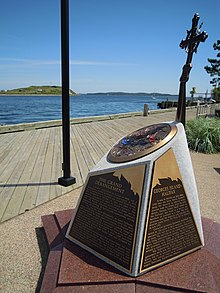
During this time period, Halifax continued to be fortified by the Northwest Arm Battery (1761) and the Point Pleasant Battery (1763), both located in present-day Point Pleasant Park.[49] After the French conquered St. John's, Newfoundland in June 1762, the success galvanized both the Acadians and Natives. They began gathering in large numbers at various points throughout the province and behaving in a confident and, according to the British,"insolent fashion". Officials were especially alarmed when Natives concentrated close to the two principal towns in the province, Halifax and Lunenburg, where there were also large groups of Acadians. The government organized an expulsion of 1300 people, shipping them to Boston. The government of Massachusetts refused the Acadians permission to land and sent them back to Halifax.[50]
Before the deportation, Acadian population was estimated at 14,000 Acadians. Most were deported.[51] Some Acadians escaped to Quebec, or hid among the Mi'kmaq or in the countryside, to avoid deportation until the situation settled down.[52]
The war ended and Britain had gained control over the entire Maritime region.
Acadian, Maliseet and Mi’kmaq resistance
During the expulsion, French Officer
Annapolis (Fort Anne)
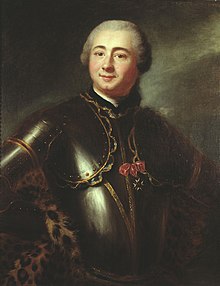
The Acadians and Mi’kmaq fought in the Annapolis region. They were victorious in the
In December 1757, while cutting firewood near Fort Anne, John Weatherspoon was captured by Indians (presumably Mi'kmaq) and carried away to the mouth of the Miramichi River. From there he was eventually sold or traded to the French and taken to Quebec, where he was held until late in 1759 and the Battle of the Plains of Abraham, when General Wolfe's forces prevailed (See Journal of John Witherspoon, Annapolis Royal) .[56]
About 50 or 60 Acadians who escaped the initial deportation are reported to have made their way to the Cape Sable region (which included south western Nova Scotia). From there, they participated in numerous raids on Lunenburg, Nova Scotia.[57]
Piziquid (Fort Edward)
In the April 1757, a band of Acadian and Mi'kmaq raided a warehouse near
Chignecto (Fort Cumberland)
The Acadians and Mi’kmaq also resisted in the Chignecto region. They were victorious in the Battle of Petitcodiac (1755).[55] In the spring of 1756, a wood-gathering party from Fort Monckton (former Fort Gaspareaux), was ambushed and nine were scalped.[63] In the April 1757, after raiding Fort Edward, the same band of Acadian and Mi'kmaq partisans raided Fort Cumberland, killing and scalping two men and taking two prisoners.[64] July 20, 1757 Mi'kmaq killed 23 and captured two of Gorham's rangers outside Fort Cumberland near present-day Jolicure, New Brunswick.[65] In March 1758, forty Acadian and Mi'kmaq attacked a schooner at Fort Cumberland and killed its master and two sailors.[66] In the winter of 1759, the Mi'kmaq ambushed five British soldiers on patrol while they were crossing a bridge near Fort Cumberland. They were ritually scalped and their bodies mutilated as was common in the savage warfare of the Indians.[67] During the night of 4 April 1759, using canoes, a force of Acadians and French captured the transport. At dawn they attacked the ship Moncton and chased it for five hours down the Bay of Fundy. Although the Moncton escaped, its crew suffered one killed and two wounded.[68]
Others resisted during the
Lawrencetown

By June 1757, the settlers had to be withdrawn completely from the settlement of Lawrencetown (established 1754) because the number of Indian raids eventually prevented settlers from leaving their houses.[70]
In nearby Dartmouth, Nova Scotia, in the spring of 1759, there was another Mi'kmaq attack on Eastern Battery, in which five soldiers were killed.[71]
Maine
In present-day Maine, the Mi’kmaq and the Maliseet raided numerous New England villages. At the end of April 1755, they raided Gorham, Maine, killing two men and a family. Next they appeared in New-Boston (Gray) and through the neighbouring towns destroying the plantations. On May 13, they raided Frankfort (Dresden), where two men were killed and a house burned. The same day they raided Sheepscot (Newcastle), and took five prisoners. Two were killed in North Yarmouth on May 29 and one taken captive. They shot one person at Teconnet. They took prisoners at Fort Halifax; two prisoners taken at Fort Shirley (Dresden). They took two captive at New Gloucester as they worked on the local fort.[72] During the Seven Years' War, on June 9, 1758, Indians raided the Woolwich, Maine, killing members of the Preble family and taking others prisoner to Quebec.[73] This incident became known as the last conflict on the Kennebec River.
On 13 August 1758 Boishebert left
Lunenburg
The Acadians and Mi'kmaq raided the
During the summer of 1758, there were four raids on the Lunenburg Peninsula. On 13 July 1758, one person on the LaHave River at Dayspring was killed and another seriously wounded by a member of the Labrador family.[80] The next raid happened at Mahone Bay, Nova Scotia, on 24 August 1758, when eight Mi'kmaq attacked the family homes of Lay and Brant. While they killed three people in the raid, the Mi'kmaq were unsuccessful in taking their scalps, which was the common practice for payment from the French.[81] Two days, later, two soldiers were killed in a raid on the blockhouse at LaHave, Nova Scotia.[82] Almost two weeks later, on 11 September, a child was killed in a raid on the Northwest Range.[83] Another raid happened on 27 March 1759, in which three members of the Oxner family were killed.[77] The last raid happened on 20 April 1759. The Mi’kmaq killed four settlers at Lunenburg who were members of the Trippeau and Crighton families.[84]
Halifax
On 2 April 1756, Mi'kmaq received payment from the Governor of Quebec for 12 British scalps taken at Halifax.
In July 1759, Mi'kmaq and Acadians kill five Britons in Dartmouth, opposite McNabb's Island.[87]
Halifax Treaties
After agreeing to several peace treaties, the seventy-five year period of war ended with the
Headquarters of the North American Station
Halifax was the headquarters for the Royal Navy's
American Revolution
At the outbreak of the outbreak of the American Revolution, many Nova Scotians were New England-born and were sympathetic to the American Patriots. This support somewhat eroded over the first two years of the war as American Privateers attacked Nova Scotian villages and shipping to try to interrupt Nova Scotian trade with the American Loyalists still in New England who were opposing the Revolution. During the war, American Privateers captured 225 vessels either leaving or arriving at Nova Scotia ports.[88]
Nineteenth century
French Revolutionary Wars
Halifax was now the bastion of British strength on the East Coast of North America. Local merchants also took advantage of the exclusion of American trade to the British colonies in the Caribbean, beginning a long trade relationship with the West Indies. However, the most significant growth began with the beginning of the French Revolutionary Wars. Military spending and the opportunities of wartime shipping and trading stimulated growth led by local merchants such as Simeon Perkins, Charles Ramage Prescott and Enos Collins. The most renown privateer was Captain Alexander Godfrey of the Rover from Liverpool, Nova Scotia.
Conquest of Saint Pierre and Miquelon
In 1793, under the command of Brigadier General
Prince Edward arrives
By 1796,
Napoleonic Wars
Trafalgar Day

During the
Halifax Impressment Riot
The towns people and especially seafarers were constantly on-guard of the
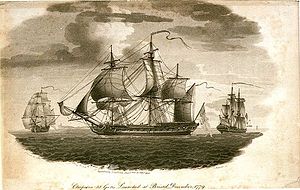
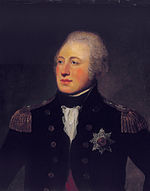
The Navy's manning problems in Nova Scotia peaked in 1805. Warships were short-handed from high desertion rates, and naval captains were handicapped in filling those vacancies by provincial impressment regulations. Desperate for sailors, the Navy pressed them all over the North Atlantic region in 1805, from Halifax and Charlottetown to Saint John and Quebec City. In early May, Vice Admiral Andrew Mitchell sent press gangs from several warships into downtown Halifax. They conscripted men first and asked questions later, rounding up dozens of potential recruits.[94]
The breaking point came in October 1805, when Vice-Admiral Mitchell allowed press gangs from HMS Cleopatra to storm the streets of Halifax armed with bayonets, sparking a major riot in which one man was killed and several others were injured. Wentworth lashed out at the admiral for sparking urban unrest and breaking provincial impressment laws, and his government exploited this violent episode to put even tighter restrictions of recruiting in Nova Scotia.[95][96]

Stemming from impressment disturbances, civil-naval relations deteriorated in Nova Scotia from 1805 to the War of 1812. HMS Whiting was in Liverpool for only about a week, but it terrified the small town the entire time and naval impressment remained a serious threat to sailors along the South Shore. After leaving Liverpool, Whiting terrorized Shelburne by pressing inhabitants, breaking into homes, and forcing more than a dozen families to live in the forest to avoid further harassment.[97]
Invasion of Martinique (1809)
War of 1812
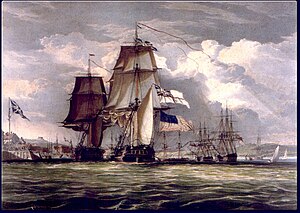
In the lead-up to the War of 1812, the Little Belt affair created excitement in Nova Scotia. Having departed Annapolis Royal, on May 27, 1811, the British vessel Little Belt arrived in Halifax with many of the crew killed or wounded after having been attacked by an American vessel.[102] At the outset of the war, Nova Scotia was again alarmed when USS Constitution was off the coast and defeated HMS Guerriere, which had just departed from Halifax.[103][104] (A month earlier HMS Belvidera had arrived in port having escaped an attack.)[105]
During the War of 1812, Nova Scotia's contribution to the war effort was communities either purchasing or building various privateer ships to seize American vessels.
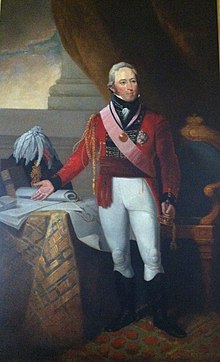
Perhaps the most dramatic moment in the war for Nova Scotia was when
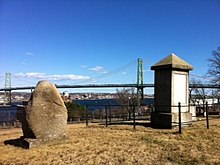
On September 3, 1814, a British fleet from Halifax, Nova Scotia, began to
The most famous soldier that was buried in Nova Scotia during the war was
Crimean War
Nova Scotians fought in the
In the wake of the Crimean War, the second black military unit in Canada (one of the first in Nova Scotia) was formed, Victoria Rifles (Nova Scotia) (1860).
One resident of Halifax named his home Alma Villa after the Battle of Alma.[121]
Indian Mutiny

Nova Scotians also participated in the
American Civil War
Over 200 Nova Scotians have been identified as fighting in the
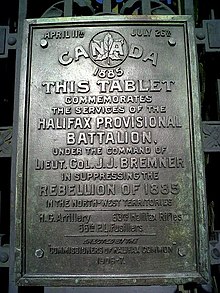
The British Empire (including Nova Scotia) declared neutrality, and Nova Scotia prospered greatly from trade with the North. Nova Scotia was the site of two minor international incidents during the war: the Chesapeake Affair and the escape from Halifax Harbour of the CSS Tallahassee, aided by Confederate sympathizers.[124] Nova Scotia became a haven for Confederate Secret Service agents and supporters and had a role in engaging in blockade running with arms largely from Britain. Blockade runners stopped in Halifax to rest and refuel where they were to pass through the Union blockade to deliver supplies to the Confederate Army. Nova Scotia's role in arms trafficking to the South was so noticeable that the Acadian Recorder in 1864 described Halifax's effort as a "mercenary aid to a fratricidal war, which, without outside intervention, would have long ago ended."[125] U.S. Secretary of State William H. Seward complained on March 14, 1865:
Halifax has been for more than one year, and yet is, a naval station for vessels which, running the blockade, furnish supplies and munitions of war to our enemy, and it has been made a rendezvous for those piratical cruisers which come out from Liverpool and Glasgow, to destroy our commerce on the high seas, and even to carry war into the ports of the United States. Halifax is a postal and despatch station in the correspondence between the rebels at Richmond and their emissaries in Europe. Halifax merchants are known to have surreptitiously imported provisions, arms, and ammunition from our seaports, and then transshipped them to the rebels. The governor of Nova Scotia has been neutral, just, and friendly; so were the judges of the province who presided on the trial of the Chesapeake. But then it is understood that, on the other hand, merchant shippers of Halifax, and many of the people of Halifax, are willing agents and abettors of the enemies of the United States, and their hostility has proved not merely offensive but deeply injurious.[126]
The war left many fearful that the North might attempt to annex British North America, particularly after the Fenian raids began (many Americans considered the Fenian raids as retribution against British-Canadian tolerance of and even aid to Confederate Secret Service activities in Canada against the Union during the Civil War (such as the Chesapeake Affair and the St. Albans Raid).[127][128][129][130] In response, volunteer regiments were raised across Nova Scotia. British commander and Lt Governor of Nova Scotia Charles Hastings Doyle (after whom Port Hastings is named) led 700 troops out of Halifax to crush a Fenian attack on the New Brunswick border with Maine. This rather baseless scare was one of the main reasons why Britain sanctioned the creation of Canada (1867); to avoid another possible conflict with America and to leave the defence of Nova Scotia to a Canadian Government.[131]
North-West Rebellion
The
Prior to Nova Scotia's involvement, the province remained hostile to Canada in the aftermath of how the colony was forced into Canada. The celebration that followed the Halifax Provisional Battalion's return by train across the county ignited a national patriotism in Nova Scotia. Prime Minister Robert Borden stated that "up to this time Nova Scotia hardly regarded itself as included in the Canadian Confederation.... The rebellion evoked a new spirit.... The Riel Rebellion did more to unite Nova Scotia with the rest of Canada than any event that had occurred since Confederation." Similarly, in 1907 Governor General Earl Grey declared, "This Battalion... went out Nova Scotians, they returned Canadians." The wrought iron gates at the Halifax Public Gardens were made in the Battalion's honour.[133]
Twentieth century
Second Boer War

During the Second Boer War (1899–1902), the First Contingent was composed of seven Companies from across Canada. The Nova Scotia Company (H) consisted of 125 men. (The total First Contingent was a total force of 1,019. Eventually over 8600 Canadians served.) The mobilization of the Contingent took place at Quebec. On October 30, 1899, the ship Sardinian sailed the troops for four weeks to Cape Town. The Boer War marked the first occasion in which large contingents of Nova Scotian troops served abroad (individual Nova Scotians had served in the Crimean War). The Battle of Paardeberg in February 1900 represented the second time Canadian soldiers saw battle abroad (the first being the Canadian involvement in the Nile Expedition).[134] Canadians also saw action at the Battle of Faber's Put on May 30, 1900.[135] On November 7, 1900, the Royal Canadian Dragoons engaged the Boers in the Battle of Leliefontein, where they saved British guns from capture during a retreat from the banks of the Komati River.[136] Approximately 267 Canadians died in the War. 89 men were killed in action, 135 died of disease, and the remainder died of accident or injury. 252 were wounded.
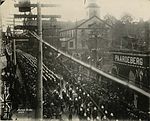
Of all the Canadians who died during the war, the most famous was the young Lt.
For two decades afterwards, Canadians would gather on February 27 (known in Canada as "Paardeberg Day") around memorials to the South African War to say prayers and honour veterans. This continued until the end of the
First World War
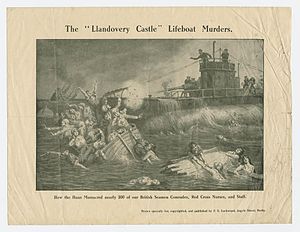
The
During
On 27 June 1917, a German U-boat torpedoed a hospital ship from the port of Halifax named HMHS Llandovery Castle. Escaping lifeboats were pursued and sunk by the U-boat and the survivors machine-gunned. Of the crew totalling 258, only twenty-four survived.[142] The commander of the ship, Lt.-Col. Thomas Howard MacDonald, was from Nova Scotia as was the nursing Matron, Margaret Marjory Fraser (daughter of Lt. Governor of Nova Scotia Duncan Cameron Fraser). Lt.-Col MacDonald died as did Fraser along with the 13 nurses under her command.
On Thursday, December 6, 1917, the city of Halifax, Nova Scotia, Canada, was devastated by
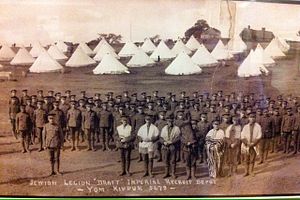
Founders of the League of Nations included David Ben-Gurion, who became the first prime minister of Israel, and Ze'ev Jabotinsky; both men were trained at Fort Edward. At age 70, David Ben-Gurion reported on his time at Fort Edward: "I will never forget Windsor where I received my first training as a soldier and where I became a corporal."[145]
The
Three Nova Scotian battalions saw combat in Europe as distinct fighting units –
The 36th Battery, Canadian Field Artillery, was raised out of Sydney, Cape Breton in September 1915 by Major Walter Crowe, a prominent lawyer and former mayor of Sydney.[147]
The
Spanish Civil War
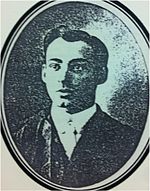
The
Second World War
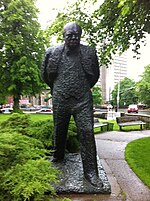
During
From the start of the war in 1939 until VE Day, several of Canada's Atlantic coast ports became important to the resupply effort for the United Kingdom and later for the Allied land offensive on the Western Front. Halifax and
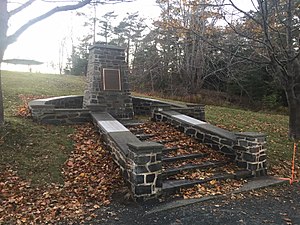
Although not crippling to the Canadian war effort, given the country's rail network to the east coast ports, but possibly more destructive to the morale of the Canadian public, was the Battle of the St. Lawrence, when U-boats began to attack domestic coastal shipping along Canada's east coast in the St. Lawrence River and Gulf of St. Lawrence from early 1942 through to the end of the shipping season in late 1944.
SS Caribou was a Newfoundland Railway passenger ferry that ran between Port aux Basques, in the Dominion of Newfoundland, and North Sydney, Nova Scotia between 1928 and 1942. It became infamous when it was attacked and sunk by German submarine U-69 in October 1942, while traversing the Cabot Strait as part of its three weekly SPAB convoys. As a civilian vessel, it had women and children on board, and many of them were among the 137 who died. Its sinking, and large death toll, made it clear that the war had really arrived on Canada's and Newfoundland's home front, and is cited by many historians as the most significant sinking in Canadian-controlled waters during the Second World War.[152] In the Cabot Strait, just off Cape Breton, on 25 November 1944 HMCS Shawinigan was torpedoed and sunk with all hands on board (85 crew) by U-1228.

In World War I and World War II, German submarines torpedoed a number of allied ships near Sambro Island Light. For example, in World War II, while mine sweeping near Sambro Light Vessel on 24 December 1944 while preparing to escort a convoy, HMCS Clayoquot was hit by a torpedo aft fired by U-806.[153] She sank quickly and eight people died.[154] A large search force was sent out to deal with the U-boat however they were not successful in finding it.[153] In the early morning of 16 April 1945, just off Halifax harbour, U-190 sunk HMCS Esquimalt, killing 44 crew.
Several RN escorts were attached to the RCN for some months during 1942, with convoys in the St. Lawrence River and Gulf of St. Lawrence being formed between RCN facilities at
At

In May 1945, following Germany's surrender, U-889 surrendered to the RCN at Shelburne, Nova Scotia.
Korean War
During the
Afghanistan
There were 13 Nova Scotians among the 158 Canadians who were killed in the
Notable Nova Scotian military figures
The following list includes those who were born in Nova Scotia, Acadia and Mi'kma'ki or those who became
17th-18th centuries
-
Françoise-Marie Jacquelin – Civil War in Acadia
-
FatherFather Rale's War
-
Captain Charles Morris – King George's War
-
John Bradstreet – King George's War
-
Paul Mascarene – King George's War
-
Father Pierre Maillard – Father Le Loutre's War
-
Major General John Small, Commander, 84th Regiment of Foot (Royal Highland Emigrants) – American Revolution
-
Francis McLean – American Revolution
-
Col Simeon Perkins – American Revolution
- Charles de Saint-Étienne de la Tour – Acadian Civil War
- Chief Madockawando – King William's War
- John Gyles – King William's War
- Father Louis-Pierre Thury – King William's War
- Pierre Maisonnat dit Baptiste – Queen Anne's War
- Robert Denison – King George's War
- Joseph-Nicolas Gautier – Father Le Loutre's War
- Pierre II Surette – Seven Years' War
- John Allan (colonel) – American Revolution
- Benjamin Belcher – American Revolution
19th century
-
George Augustus Westphal – Battle of Trafalgar, Admiralty Garden, Stadacona, CFB Halifax, Nova Scotia
-
Sir John Coape Sherbrooke – Lt Gov. of Nova Scotia – War of 1812
-
John Charles Beckwith (army officer) – Battle of Waterloo
-
Sir William Williams, 1st Baronet, of Kars by William Gush – Crimean War
-
Major Augustus F. Welsford– Crimean War
-
Captain William B.C.A. Parker– Crimean War
-
John Wimburn Laurie – Crimean War
-
Nova Scotian SirIndian Mutiny
-
William Hall (VC) – Indian Mutiny
-
Robert Knox Sneden – American Civil War
-
Joseph B. Noil – American Civil War
-
Benjamin Jackson – American Civil War
-
Lt Gov of Nova ScotiaFenian Raids
20th century
-
Francis Joseph Fitzgerald – Second Boer War, Fitzgerald Bridge in Halifax Public Gardens
-
Walter Harris Callow – World War I, disabled veterans advocate
-
George Brenton Laurie – WW1
-
Philip Bent, VC – World War I
-
Jeremiah Jones – WW 1
-
Margaret C. MacDonald– WW1
-
John Bernard Croak, VC – World War I
-
Sam Gloade – WW1
-
James Peter Robertson, VC – WWI
-
Reverend William A. White – WW1
- William M. Jones
- Ransford D. Bucknam
- Edward Francis Arab
Nova Scotian Victoria Cross Recipients
This along with the *, indicates that the Victoria Cross was awarded posthumously
| Name | Date of action | Conflict | Unit | Place of action | Province of origin | Notes |
|---|---|---|---|---|---|---|
Philip Bent |
1917* | First World War | The Leicestershire Regiment |
Polygon Wood, Belgium | Nova Scotia[158] | |
John Croak |
1918* | First World War | 13th Battalion, CEF |
Amiens, France | Nova Scotia[159] | |
| William Hall | 1857 | Indian Mutiny | HMS Shannon | Lucknow, India | Nova Scotia[160] | |
| John Kerr | 1916 | First World War | 49th Battalion, CEF |
Courcelette, France | Nova Scotia[161] | |
| James Robertson | 1917* | First World War | 27th Battalion, CEF |
Passchendaele, Belgium | Nova Scotia[162] |
Communities and streets named after military leaders and battles
King Georges War
- Shirley St., Halifax, William Shirley
- Pepperell St., Halifax William Pepperell
- Mascarene Ave., Halifax, Paul Mascarene
Father Le Loutre's War
- Port Hawkesbury, Edward Hawke, 1st Baron Hawke
- Morris St., Halifax, Charles Morris (jurist)
- Lawrencetown, Nova Scotia, Charles Lawrence
- Cornwallis, Nova Scotia, Edward Cornwallis
- Cornwalliis St., Halifax, Edward Cornwallis
Seven Years' War
- Jeffery Amherst
- Cumberland County, Nova Scotia, Prince William, Duke of Cumberland
- Montague St., Lunenburg, Nova Scotia, Montague Wilmot
American Revolution
- Belcher Street, Port Williams, Nova Scotia, Lieut. Benjamin Belcher, hero of Battle of Blomindon
- Guysborough, Nova Scotia (Guy's borough), Guy Carleton, 1st Baron Dorchester[163]
- Carleton Corner
- Carleton Village, Nova Scotia
- Samuel Birch, compiler of the Book of Negroes
- Francis Rawdon-Hastings
- Digby, Nova Scotia, Admiral Robert Digby (Royal Navy officer)
- Abercrombie, Nova Scotia, General James Abercrombie
- Tiddville, Nova Scotia, Samuel Tidd, a private for Col. Beverley Robinson
- Gilbert Cove, Nova Scotia, Lt. Thomas Gilbert
- Barton, Nova Scotia, Lt. Col. Joseph Barton (military officer)
- Russell Lake, Nova Scotia, Nathaniel Russell
- Parrsboro, Nova Scotia, John Parr
- Wentworth, Nova Scotia, Sir John Wentworth, 1st Baronet
- Wentworth Valley, Nova Scotia
- Wentworth Station, Nova Scotia
- Douglas, Nova Scotia, Sir Charles Douglas, 1st Baronet[164]
Napoleonic Wars
- Port Hood, Nova Scotia
- Westphal, Nova Scotia, George Augustus Westphal
- Castine Way, Dalhousie University, Halifax, Battle of Hampden
- Provo Wallis St., Halifax Dockyard, Provo Wallis
- Martinique, Nova Scotia, Invasion of Martinique (1809)
- Waterloo St. Halifax, Battle of Waterloo
- Wellington, St., Halifax, Arthur Wellesley, 1st Duke of Wellington
- Sherbrooke, Nova Scotia, John Coape Sherbrooke
- Admiral Rock, Nova Scotia, Admiral Alexander Cochrane
- Lake Ainslie, Ainslieview, Nova Scotia and Ainslie Point, Nova Scotia, George Robert Ainslie
- Kempt Shore, Nova Scotia, James Kempt
- Kempt Road, Nova Scotia
- Kempt Road, Halifax, Nova Scotia
- Kempt Street, Lunenburg
Crimean War
- Lucknow St., Halifax, Siege of Lucknow
- Inglis St., Halifax, John Eardley Inglis
- Havelock, Nova Scotia, Henry Havelock
- Sir William Williams, 1st Baronet, of Kars
- Sir William Williams, 1st Baronet, of Kars
- Parker St., Halifax, Sebastopol Monument
- Welsford St., Halifax, Sebastopol Monument
- Welsford St., Pictou, Nova Scotia
- Battle of Alma
American Civil War
- Ben Jackson Road (exit 8A Highway 101), Benjamin Jackson (soldier)
- Port Hastings, Nova Scotia, Charles Hastings Doyle
Boer War
See also
- Halifax Treaties
- The Nova Scotia Highlanders
- Naval Museum of Halifax
- Halifax Armoury
- CFB Greenwood
- CFB Halifax
- History of Nova Scotia
- History of New Brunswick
- History of the Halifax Regional Municipality
- Royal Nova Scotia Historical Society
- Military history of the Mi’kmaq people
- Military history of the Acadians
- Military history of Canada
References
- ^ a b William Williamson. The history of the state of Maine. Vol. 2. 1832. p. 27
- ^ Also, that same year, French fishermen established a settlement at Canso.
- ^ Dunn (2004).
- ^ Nicholls, Andrew. A Fleeting Empire: Early Stuart Britain and the Merchant Adventures to Canada. McGill-Queen's University Press. 2010.
- ^ M. A. MacDonald, Fortune & La Tour: The civil war in Acadia, Toronto: Methuen. 1983
- ^ Dunn (2004), p. 19.
- ^ Dunn (2004), p. 20.
- ^ "Wabanaki". wabanaki.com. Archived from the original on July 19, 2011. Retrieved August 5, 2015.
- JSTOR j.ctt15jjfrm.
- ^ Harry Piers (1927). "Regiments Raised in Nova Scotia". Collections of the Nova Scotia Historical Society. Retrieved August 5, 2015.
- ^ Grenier, p. 56
- ^ Murdoch (1865), p. 399.
- ^ Murdoch (1865), p. 398.
- ^ The Nova Scotia theatre of the Dummer War is named the "Mi'kmaq-Maliseet War" by John Grenier. The Far Reaches of Empire: War in Nova Scotia 1710–1760. University of Oklahoma Press. 2008.
- ^ Murdoch (1865), p. 399; Geoffery Plank, An Unsettled Conquest, p. 78
- ^ Benjamin Church, p. 289; John Grenier, p. 62
- ^ Faragher, John Mack, A Great and Noble Scheme New York; W. W. Norton & Company, 2005. pp. 164-165.; Murdoch (1865), pp. 408–409
- ^ Dunn (2004), p. 123.
- ^ Dunn (2004), pp. 124–125.
- ^ Haynes, Mark. The Forgotten Battle: A History of the Acadians of Canso/ Chedabuctou. British Columbia: Trafford. 2004, p. 159
- ^ Wicken (2002), p. 72.
- ^ British Museum
- ^ The framework Father Le Loutre's War is developed by John Grenier in his books The Far Reaches of Empire. War in Nova Scotia, 1710–1760. (University of Oklahoma Press, 2008) and The first way of war: American war making on the frontier, 1607–1814 (Cambridge University Press, 2005). He outlines his rational for naming these conflicts as Father Le Loutre's War; Thomas Beamish Akins. History of Halifax, Brookhouse Press. 1895. (2002 edition). p 7
- ^ a b John Grenier. The Far Reaches of Empire: War in Nova Scotia, 1710–1760. Oklahoma University Press.
- ISBN 978-0-19-543101-8.
- ^ John Grenier, Far Reaches of Empire: War in Nova Scotia 1710–1760. Oklahoma Press. 2008
- JSTOR 10.3138/j.ctt15jjfrm.
- ISBN 2-89448-513-1; Ernest Martin (1936) Les Exilés Acadiens en France et leur établissement dans le Poitou, Paris, Hachette, 1936). Very few eventually returned to Nova Scotia. See Faragher (2005)
- ^ Faragher 2005, p. 338
- ^ a b John Grenier. The Far Reaches of Empire: War in Nova Scotia, 1710–1760. Oklahoma University Press. 2008
- ^ John Grenier, p. 184
- ^ Winthrop Bell. Foreign Protestants, University of Toronto, 1961, p. 504; Peter Landry. The Lion and the Lily, Trafford Press. 2007.p. 555
- ^ John Grenier, The Far Reaches of Empire, Oklahoma Press. 2008. p. 198
- ^ Marshall, p. 98; see also Bell. Foreign Protestants. p. 512
- ^ Marshall, p. 98; Peter Landry. The Lion and the Lily, Trafford Press. 2007. p. 555
- ^ Earle Lockerby, The Expulsion of the Acadians from Prince Edward Island. Nimbus Publications. 2009
- ^ Plank, p. 160
- ^ John Grenier, p. 197
- ^ Grenier, p. 198; Faragher, p. 402.
- ^ Grenier, p. 198
- ^ John Grenier. The Far Reaches of Empire: War in Nova Scotia, 1710–1760, Oklahoma University Press.pp. 199-200. Note that Faragher (2005), p 405 indicates that Monckton had a force of 2000 men for this campaign.
- ^ a b John Grenier. The Far Reaches of Empire: War in Nova Scotia, 1710–1760, Oklahoma University Press. 2008, pp. 199-200
- ^ a b John Grenier. The Far Reaches of Empire: War in Nova Scotia, 1710–1760. Oklahoma University Press, p. 202; Also see Plank, p. 61
- ^ A letter from Fort Frederick which was printed in Parker’s New York Gazette or Weekly Post-Boy on 2 April 1759 provides some additional details of the behavior of the Rangers. Also see Raymond, Wm. O. (1910). The River St. John: Its Physical Features, Legends and History, from 1604 to 1784. Saint John, New Brunswick: John A. Bowes. pp. 96–107.
- ^ McLennan, J.S. (1918). Louisbourg, from Its Foundation to Its Fall, 1713–1758. London: Macmillan. pp. 417–423, Appendix 11.
- ^ Lockerby, 2008, p.17, p.24, p.26, p.56
- ^ Faragher 2005, p. 414; also see History: Commodore Byron's Conquest. The Canadian Press. July 19, 2008 http://www.acadian.org/La%20Petite-Rochelle.html
- ^ John Grenier, p. 211; Faragher 2005, p. 41; see the account of Captain Mackenzie's raid at MacKenzie's Raid
- ^ Tom Tulloch. 2015. Point Pleasant Park Pamphlet.
- ^ Patterson, 1994, p. 153; Dunn (2004), p. 207
- ^ Griffiths (2005), p. 438.
- ^ Faragher, p. 423–424
- ^ John Gorham. The Far Reaches of Empire: War In Nova Scotia (1710–1760). University of Oklahoma Press. 2008. p. 177-206
- ^ Patterson, Stephen E. 1744–1763: Colonial Wars and Aboriginal Peoples. In Phillip Buckner and John Reid (eds.) The Atlantic Region to Conderation: A History. Toronto: University of Toronto Press. 1994. p. 148
- ^ a b Faragher 2005, pp. 110
- ^ The journal of John Weatherspoon was published in Collections of the Nova Scotia Historical Society for the Years 1879–1880 (Halifax 1881) that has since been reprinted (Mika Publishing Company, Belleville, Ontario, 1976).
- ^ Winthrop Bell, Foreign Protestants, University of Toronto. 1961. p.503
- ^ Faragher 2005, p. 398.
- ^ John Faragher. Great and Noble Scheme. Norton. 2005. p. 398.
- ^ Knox. Vol. 2, p. 443 Bell, p. 514
- ISBN 9780665364563. Retrieved August 5, 2015.
- ^ The oldest gravestone is in the Old Burying Ground (Halifax, Nova Scotia) (1752)
- ^ Webster as cited by bluepete, p. 371
- ^ John Faragher.Great and Noble Scheme. Norton. 2005. p. 398.
- ^ John Grenier, p. 190; New Brunswick Military Project
- ^ John Grenier, p. 195
- ^ Faragher 2005, p. 410
- ^ "Fredericton | Faculty of Arts | Centres | The Gregg Centre | New Brunswick Military Heritage Project | UNB". unb.ca. Retrieved August 5, 2015.
- ^ John Grenier. The Far Reaches of Empire: War in Nova Scotia, 1710–1760, Oklahoma University Press.pp. 199–200
- ^ Bell Foreign Protestants. p. 508
- ^ Harry Chapman, p. 32; Faragher 2005, p. 410
- ^ William Williamson. The history of the state of Maine. Vol. 2. 1832. p. 311-112; During this time period, the Maliseet and Mi'kmaq were the only tribes of the Wabanaki Confederacy who were able to right.
- ^ "Preble Massacre". preblefamily.org. Retrieved August 5, 2015.
- ^ Leblanc, Phyllis E. (1979). "Deschamps de Boishébert et de Raffetot, Charles". In Halpenny, Francess G (ed.). Dictionary of Canadian Biography. Vol. IV (1771–1800) (online ed.). University of Toronto Press.
- ^ Eaton, Cyrus (1865). History of Thomaston, Rockland, and South Thomaston, Maine, from their First Exploration, 1605; with Family Genealogies. Hallowell, Maine: Masters, Smith & Co. p. 77.
- ^ William Durkee Williamson, The history of the state of Maine: from its first discovery, A. D ..., Volume 2, p. 333 (Williamson's Book)
- ^ a b Archibald McMechan, Red Snow of Grand Pre. 1931. p. 192
- ^ Bell, p. 509
- ^ Bell. Foreign Protestants. p. 510, p. 513
- ^ Bell, p. 510
- ^ Bell, Foreign Protestants, p. 511
- ^ Bell, p. 511
- ^ Bell, p. 512
- ^ Bell, p. 513
- ^ J.S. McLennan. Louisbourg: From its foundation to its fall (1713–1758). 1918, p. 190
- ^ Earle Lockerby. Pre-Deportation Letters from Ile Saint Jean. Les Cahiers. La Societe hitorique acadienne. Vol. 42, No2. June 2011. pp. 99-100
- ^ Murdoch (1866), p. 366.
- ^ Julian Gwyn. Frigates and Foremasts. University of British Columbia. 2003. p. 56
- ^ "No. 13542". The London Gazette. June 29, 1793. p. 554.
- ^ "No. 13940". The London Gazette. October 11, 1796. p. 966.
- ^ Thomas Atkins. History of Halifax.
- ^ Cuthbertson 2009, p. 9.
- ^ Keith Mercer. Trafalgar Days in Nova Scotia. Trident News. October 27, 2014, Vol. 47, No. 22. p. 13
- ^ Mercer, p. 232
- ^ Mercer, p. 236
- ^ Thomas B. Akins, History of Halifax City (Halifax, 1895), 137–8; Brian C. Cuthbertson, The Loyalist Governor: Biography of Sir John Wentworth (Halifax: Petheric, 1983), 132–4; Executive Council Minutes, 23 Nov. 1805, 161–2, vol. 191, RG1, nsarm; John George Marshall, A Brief History of Public Proceedings and Events, Legal – Parliamentary –and Miscellaneous, in the Province of Nova Scotia, during the Earliest Years of the Present Century (Halifax, 1879), 22–4.
- ^ Mercer, p. 235
- ^ a b Burroughs, Peter (1983). "Prevost, Sir George". In Halpenny, Francess G (ed.). Dictionary of Canadian Biography. Vol. V (1801–1820) (online ed.). University of Toronto Press. Retrieved August 5, 2015.
- ^ There has also been the suggestion that the beach is named after Prince Edward who took part in the 1794 Capture of Martinique (see Prince Edward - Martinique).
- ^ Thomas Akins. History of Halifax. p. 144
- ^ Naval Chronicle. Celebration for Prevost in Halifax.
- ^ Thomas Akins. History of Halifax. p. 149
- ^ Thomas Akins. History of Halifax, p. 154
- ^ Naval Chronicle, Vol. 28. p. 316
- ^ Thomas Akins. History of Halifax.p. 153
- ^ "American vessels captured by the British during the revolution and war of 1812". Salem, Mass., The Essex institute. 1911.
- ^ John Boileau. Half-hearted Enemies: Nova Scotia, New England and the War of 1812. Halifax: Formac Publishing. 2005. p.53
- ^ Naval Chronicle, p. 257
- ^ Naval Chronicle, Vol.29.p. 251
- ^ Naval Chronicle. Vol.29. p. 341
- ^ "The Naval chronicle : Containing a general and biographical history of the royal navy of the United kingdom with a variety of original papers on nautical subjects".
- ^ "The Naval chronicle : Containing a general and biographical history of the royal navy of the United kingdom with a variety of original papers on nautical subjects".
- ^ C.H.J. Snider, Under the Red Jack: privateers of the Maritime Provinces of Canada in the War of 1812 (London: Martin Hopkinson & Co. Ltd, 1928), 225-258 (see http://www.1812privateers.org/Ca/canada.htm#LG Archived 2010-08-16 at the Wayback Machine)
- ^ a b John Boileau. 2005. Half-hearted Enemies: Nova Scotia: New England and the War of 1812. Formac Press
- ^ Ellis (2009), pp. 99-100. The wounded were taken to
- ^ Naval Chronicle
- ^ Seymour, p. 10
- ^ Tom Seymour, Tom Seymour's Maine: A Maine Anthology (2003), pp. 10-17
- ^ Burroughs, Peter (1987). "Sherbrooke, Sir John Coape". In Halpenny, Francess G (ed.). Dictionary of Canadian Biography. Vol. VI (1821–1835) (online ed.). University of Toronto Press. Retrieved August 5, 2015.
- ^ D.C. Harvey, "The Halifax–Castine expedition," Dalhousie Review, 18 (1938–39): 207–13.
- ^ Ballard, Joseph. Historic House Names of Nova Scotia. Nimbus Publishing. 2018. p. 133
- ^ Greg Marquis, "Mercenaries or Killer Angels? Nova Scotians in the American Civil War," Collections of the Royal Nova Scotia Historical Society, 1995, Vol. 44, pp 83-94
- ^ "All Men are Brothers :: Civil War :: Articles :: Lest We Forget". Archived from the original on May 24, 2014. Retrieved August 5, 2015.
- ^ Greg Marquis, In Armageddon’s Shadow: The Civil War and Canada’s Maritime Provinces. McGill-Queen’s University Press. 1998.
- ^ Greg Marquis (January 1998). "The Ports of Halifax and Saint John and the American Civil War" (PDF). 8 (1). The Northern Mariner: 4.
{{cite journal}}: Cite journal requires|journal=(help) - ^ Beau Cleland. Between King Cotton and Queen Victoria: Confederate Informal Diplomacy and Privatized Violence in British America During the American Civil War (Thesis). University of Calgary. p. 2.
- ^ Kevin Plummer (May 21, 2011). "Historicist: Confederates and Conspirators". Torontoist.
- ^ "10 ways Canada fought the American Civil War". Maclean's. August 4, 2014.
- ^ Peter Kross (Fall 2015). "The Confederate Spy Ring: Spreading Terror to the Union". Warfare History network.
- ^ "Montreal, City of Secrets: Confederate Operations in Montreal During the American Civil War". Baraka Books.
- ^ Marquis, In Armageddon’s Shadow
- ^ The history of the North-west rebellion of 1885: Comprising a full and ... By Charles Pelham Mulvany, Louis Riel, p. 410
- ^ David A. Sutherland. "Halifax Encounter with the North-West Uprising of 1885". Journal of the Royal Nova Scotia Historical Society. Vol. 13, 2010. p. 73
- ^ Canadian War Museum (2008). "Battle of Paardeberg". Canadian War Museum. Archived from the original on July 18, 2007. Retrieved May 10, 2008.
- ^ Canadian War Museum (2008). "Battle of Faber's Put". Canadian War Museum. Archived from the original on July 18, 2007. Retrieved May 10, 2008.
- ^ Canadian War Museum (2008). "Battle of Leliefontein". Canadian War Museum. Archived from the original on March 24, 2012. Retrieved May 10, 2008.
- ^ "Capt. Harold Borden, Canning Nova Scotia". angloboerwarmuseum.com. Retrieved August 5, 2015.
- ^ John Bell. Confederate Seadog: John Taylor Wood in War and Exile. McFarland Publishers. 2002. p. 59
- ^ According to a memorial plaque at the Army Museum at Citadel Hill, Halifax, there were 5 other Nova Scotia casualties in the war, 1 from PEI and another from NB.
- Canadian Encyclopedia.
- ^ The Halifax Explosion and the Royal Canadian Navy John Armstrong, University of British Columbia Press, 2002, p.10-11.
- ^ ""Angels of Mercy": Canada's Nursing Sisters in World War I and II | Peace and War in the 20th Century". pw20c.mcmaster.ca. Archived from the original on November 18, 2015. Retrieved August 5, 2015.
- ^ "CBC – Halifax Explosion – The Explosion". cbc.ca. Retrieved August 5, 2015.
- ^ Jay White, "Exploding Myths: The Halifax Explosion in Historical Context", Ground Zero: A Reassessment of the 1917 explosion in Halifax Alan Ruffman and Colin D. Howell editors, Nimbus Publishing (1994), p. 266
- ^ a b "The Valley Today: Independent News for the Annapolis Valley January 07". Retrieved August 5, 2015.
- ^ "Parks Canada – Halifax Citadel National Historic Site – Internment Operations at the Halifax Citadel during the First World War". pc.gc.ca. Archived from the original on May 10, 2015. Retrieved August 5, 2015.
- ^ "Nova Scotia's Part in the Great War". Capt. M.S. Hunt. The Nova Scotia Veteran Publishing Co. pp. 43–55. Retrieved August 18, 2018.
- ^ Renegades: Canadians in the Spanish Civil War By Michael Petrou, p. 21
- ISBN 9780773582576. Retrieved August 5, 2015.
- ^ "Veterans Affairs / Standing Committees / Committees / The Nova Scotia Legislature". nslegislature.ca. Retrieved August 5, 2015.
- ^ "OPERATION OF THE "ADMIRAL SCHEER" IN THE ATLANTIC AND INDIAN OCEANS 23 October, 1940 - 1 April, 1941. Precis of: Atlantic Kriegfuehrung (Warfare in the Atlantic) PG/36779. War Diaries of the "Admiral Scheer" PG/48430 AND 48433". United States Naval History and Heritage Command. United States Navy. January 17, 2018. Retrieved October 13, 2021.
Adopting another line of thought, Captain Krancke reasoned that there remained the possibility of the Bermuda and Halifax convoys' assembling off the Newfoundland Bank, which meant that this combined convoy would not reach the patrol area until a later date.
- ^ Tennyson & Sarty (2000), pp. 274–275.
- ^ ISBN 0-7710-3269-2.
- ISBN 0-00216-856-1.
- ^ "Premier Recognizes Nova Scotia's Korean War Veterans | novascotia.ca". novascotia.ca. Retrieved August 5, 2015.
- ^ "The Korean War and the Royal Canadian navy". Archived from the original on June 15, 2013. Retrieved April 26, 2013.
- ^ "Craig Blake remembered as Afghanistan mission ends – Nova Scotia – CBC News". cbc.ca. Retrieved August 5, 2015.
- ^ "Search Details – Veterans Affairs Canada". Vac-acc.gc.ca. Archived from the original on November 28, 2007. Retrieved January 23, 2011.
- ^ "John Bernard Croak". National Defence and the Canadian Forces. April 14, 2009. Retrieved May 5, 2012.
- ^ "William Hall". Veterans Canada. Archived from the original on March 7, 2006. Retrieved December 7, 2010.
- ^ "John Chipman Kerr". National Defence and Canadian Forces. April 14, 2009. Retrieved December 8, 2010.
- ^ "James Peter Robertson". National Defence and Canadian Forces. April 14, 2009. Retrieved December 8, 2010.
- ^ http://brian.mcconnell.tripod.com/LPNS.pdf [bare URL PDF]
- ^ "Place-names of the Province of Nova Scotia". Halifax, N.S. Royal Print. & Litho. 1922.
Bibliography
- The Wars on the Seaboard: The Struggle in Acadia and Cape Breton
- Nova Scotia - militia law
- Akins. Provincial Defenses
- Cuthbertson, Brian (2009). Melville Prison & Deadman's Island: American and French Prisoners of War in Halifax 1794–1816. Formac Press. ISBN 978-0-88780-837-1.
- Doughty, Arthur G. (1916). The Acadian Exiles. A Chronicle of the Land of Evangeline, Toronto: Glasgow, Brook & Co. 178 pages
- Douglas, W. A. B. The Sea Militia of Nova Scotia, 1749–1755: A Comment on Naval Policy. The Canadian Historical Review. Vol. XLVII, No.1. 1966. 22-37
- Dunn, Brenda (2004). A History of Port-Royal-Annapolis Royal, 1605–1800. Nimbus. ISBN 978-1-55109-740-4.
- Eaton, A. W. H. Halifax Defenses. In: Chapters in the history of Halifax, Nova Scotia (1915).
- Faragher, John Mack (2005). A Great and Noble Scheme: The Tragic Story of the Expulsion of the French Acadians from their American Homeland, New York: W.W. Norton, 562 pages ISBN 0-393-05135-8
- Grenier, John. The Far Reaches of Empire. War in Nova Scotia, 1710–1760. Norman: U of Oklahoma P, 2008. pp. 154–155
- John Grenier. The Far Reaches of Empire: War in Nova Scotia, 1710-1760. Oklahoma University Press. 2008 ISBN 978-0-8061-3876-3
- ISBN 978-0-7735-2699-0.
- ISBN 9780773031005.
- Michael L. Hadley. U-Boats Against Canada: German Submarines in Canadian Waters
- Hunt, M.S. Nova Scotia's Part in the Great War The Nova Scotia Veteran Publishing Company Limited. 1920
- Johnston, John. The Acadian Deportation in a Comparative Context: An Introduction. Royal Nova Scotia Historical Society: The Journal. 2007. pp. 114–131
- Kidder, F. MILITARY OPERATIONS IN EASTERN MAINE AND NOVA SCOTIA DURING THE REVOLUTION. (1867)
- Landry, Peter. The Lion & The Lily. Vol. 1. Victoria: Trafford, 2007.
- Loescher, Burt Garfield (1969). The History of Rogers' Rangers: The First Green Berets. San Mateo, California.
{{cite book}}: CS1 maint: location missing publisher (link) - Simon MacDonald. Ships of war lost on the coast of Nova Scotia and Sable Island during the eighteenth century (1884)
- Moody, Barry (1981). The Acadians, Toronto: Grolier. 96 pages ISBN 0-7172-1810-4
- Murdoch, Beamish (1865). A History of Nova-Scotia, Or Acadie. Vol. I. Halifax: J. Barnes.
- Murdoch, Beamish (1866). A History of Nova-Scotia, Or Acadie. Vol. II. Halifax: J. Barnes.
- Notes on Nova Scotian Privateers by George E. E. Nichols. 1904.
- Patterson, Stephen E. "1744–1763: Colonial Wars and Aboriginal Peoples". In Phillip Buckner and John Reid (eds.) The Atlantic Region to Confederation: A History. Toronto: University of Toronto Press. 1994. pp. 125–155
- Patterson, Stephen E. "Indian-White Relations in Nova Scotia, 1749–61: A Study in Political Interaction." Buckner, P, Campbell, G. and Frank, D. (eds). The Acadiensis Reader Vol 1: Atlantic Canada Before Confederation. 1998. pp. 105–106.
- Patterson, Stephen E. 1744–1763: Colonial Wars and Aboriginal Peoples. In Phillip Buckner and John Reid (eds.) The Atlantic Region to Confederation: A History. Toronto: University of Toronto Press. 1994. pp. 125–155
- Plimsoll, Joseph. The Militia of Nova Scotia, 1749-1867. Collections of the Nova Scotia Historical Society. Vol. 17 (1913). pp. 63–110.
- Rompkey, Ronald, ed. Expeditions of Honour: The Journal of John Salusbury in Halifax, Nova Scotia, 1749–53. Newark: U of Delaware P, Newark, 1982.
- Tennyson, Brian Douglas; Sarty, Roger F. (2000). Guardian of the Gulf: Sydney, Cape Breton, and the Atlantic wars. Toronto: University of Toronto Press. ISBN 978-0-8020-4492-1.
- Webster, John Clarence. The career of the Abbé Le Loutre in Nova Scotia (Shediac, N.B., 1933),
- Wicken, William C. (2002). Mi'kmaq Treaties on Trial: History, Land and Donald Marshall Junior. University of Toronto Press. ISBN 978-0-8020-7665-6.
- John G. Reid. The 'Conquest' of Acadia, 1710: Imperial, Colonial, an Aboriginal Constructions University of Toronto Press. 2004 ISBN 0-8020-3755-0
- Geoffrey Plank, An Unsettled Conquest. University of Pennsylvania. 2001 ISBN 0-8122-1869-8
- Annals of Yarmouth and Barrington (Nova Scotia) in the Revolutionary War; compiled from original manuscripts, etc., contained in the office of the secretary of the Commonwealth, State House, Boston, Mass (1899)
External links
- Government of Nova Scotia transcripts from Journal of John Winslow
- Text of Charles Lawrence's orders to Captain John Handfield - Halifax 11 August 1755
- Nova Scotia Highlanders Regimental Museum
- Nova Scotian Veterans of WW!
- British regiments in Halifax by Date
- Regiments Serving in Nova Scotia
- 74-nova-scotia-blacks-served-on-58-civil-war-vessels

























































